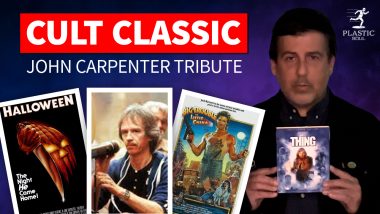THE MENACE IN QUESTION: A shape-changing alien creature.
THE THREAT: Death by blood-draining; transformation through contact/infection.
FIRST APPEARANCE: Who Goes There?, a 1938 novella by John W. Campbell, Jr. (originally under the penname Don A. Stuart) published in Astounding Science-Fiction.
E.T., the Thermians, and Paul may have come to Earth in peace – but The Thing most assuredly did not. This alien creature has no interest in Reese’s Pieces, defunct sci-fi shows, or getting high. It would rather infect humanity with its shape-changing cells and eat the leftovers.
That’s enough to make you shiver, and the Antarctic setting of the story makes it all the more bloodchilling. You can’t get much more remote, isolated, and unforgiving than an icy tundra…
It all starts when a group of scientific researchers discover an alien spacecraft buried in the ice. Not far from the craft is a creature, so naturally the men dig it up and carry the chunk of ice back to base.
Because nothing bad ever came of bringing an unknown organism home. For a bunch of men with highfalutin doctorates and degrees, they sure didn’t think this scenario through.
When the Thing thaws, that’s when the real fun begins: it promptly begins to assume the shape, memories, and personality of the men (and animals) it kills and consumes. The researchers discover it in mid-transformation as it attempts to become a sled dog, kill it, and realize that the genie’s already out of the bottle.
By now, any one of them could be the Thing in disguise.
What unfolds is a tense waiting game of paranoia as the men try to constantly keep eyes on each other, unsure of who to trust. Every man wonders, “What if I’m the last human left?” They can’t afford to let their guard down for an instant, lest the Thing attack and escape to infect the entire world.
Chilling stuff. Any one of these elements – a shape-changing predator, the remote location, the knowledge that any one of your friends could be on the verge of killing you – would be horrific enough. And John W. Campbell Jr. throws them all into a blender and presses puree.
The first adaptation of the novella, titled The Thing From Another World, hit theaters in 1951. Director Nyby and producer Howard Hawks made some significant changes to the extraterrestrial threat.
Firstly, the Thing is now humanoid in shape and plant-based; one character even refers to it as a “super carrot.”
Secondly, while it remains a killer and requires blood to survive, gone are the shape-changing and infection aspects.
Instead of emphasizing the monstrous, body horror details of the original story, The Thing From Another World instead plays upon the then-timely issues of McCarthyism – the closing dialogue warns of dangers that could already be among us and urges the audience to “keep looking” – and post-Hiroshima distrust of science.
The central theme of the film suggests that catastrophes happen when science goes too far in search of answers. If the scientists hadn’t dragged the alien back to the base, no one would have died. And in the end, the Thing is only defeated by pragmatic, quick-thinking servicemen who lure it into a trap. Most of the brainy scientists are already dead by that point.
The Thing From Another World is a fine science fiction flick. It was even named “the greatest 1950s sci-fi movie” by Time magazine and selected for preservation in the National Film Registry. But the changes made to the source material took a lot of the bite from the story.
Luckily, in 1982, John Carpenter came along and gave the Thing back its teeth. No, not teeth – they’re definitely fangs.
John Carpenter’s The Thing has very little in common with The Thing From Another World beyond the isolated polar setting. What it has instead, and has in spades, is some of the most terrifying body horror ever put on screen.
This is absolutely not a film for the squeamish or faint of heart. Blood, viscera, tentacles, and malformed dog creatures abound thanks to the twisted imagination and special effects work of Rob Bottin (a make-up maestro who deserves far more credit than he’s been given, in my humble opinion).
Carpenter fully embraces the shape-shifting element of Campbell’s story and there are several cringe-inducing sequences in the film when men transform into screeching, writhing hellbeasts.
Chests grow teeth that chomp through helping hands. Severed heads sprout eyestalks and skitter about on insectoid legs. It’s all very ooey, very gooey, very disgusting – and absolutely amazing.
Fellow horror visionary Guillermo del Toro has long cited John Carpenter’s The Thing as one of his all-time favorite movies. In a recent Twitter rant about the oft-ignored greatness of Carpenter, he had this to say:
“The Thing by John Carpenter. A game-changer (again) and one of the finest horror films ever made. It cannot be matched. Holy Grail. Make up effects, score, cinematography, production design are all utter perfection. But so is the script. The irony is that most reviewers at the time were entirely blind to the virtues of story and character. The movie bombed and was panned both. And I believe it fragmented Carpenter’s heart somewhat. F*ck them all.
Carpenter chose (like Scott in Alien) to define character and story through audio-visual coding and their interactions. Viewers needed to pay attention to the way characters related and spoke. …Not neatly packaged into a pre-digested structure. The movie was fiber, not pabulum. You had to chew. But we were at the peak of pre-chewed regurgitation. We MUST atone for the errors of the past. Masterpiece.”
Yup, it’s sad but true: John Carpenter’s The Thing was considered a dud during its initial release, a fact that continues to puzzle me to this day. How anyone could look at this master class in paranoiac pacing and not be wound to the point of snapping, alternately horrified and breathless, is beyond me.
John Carpenter’s The Thing manages to do something few horror films ever do: be both a gory, splattery horror and a psychological thriller. Which, by the end credits, is scarier? The screeching Dog-Thing, or the insidious suspicion that everyone else around you is already a monster in disguise? Whether you’re partial to one or the other, this film has you covered.
The sparse music by the great Ennio Morricone. The tension and unexpected jolts of the infamous blood test scene. The rugged determination of hero MacReady (the ever entertaining Kurt Russell, looking especially manly with a massive beard and a hat I can only call the Arctic Sombrero).
All of that plus a varied supporting cast that includes Keith David and Wilford Brimley (yes, the man now famous for his DIABEETUS commercials) and an unflinchingly nihilistic ending make John Carpenter’s The Thing one of the all-time best horror films in my book.
In the last two decades it’s gained a cult following and been re-evaluated; finally, one of Carpenter’s greatest pictures is being appreciated as the classic it truly is. Better late than never, I suppose.
But with newfound popularity came, of course, an unnecessary prequel. Hollywood decided we needed to know what happened to the Norwegian team that had unwittingly unleashed a monster onto the world.
(Spoiler alert: nothing good, as we already knew from MacReady and Doc’s visit to the charred outpost in the opening of the original movie.)
Thus, we were given 2011’s The Thing – because that title isn’t at all confusing for a prequel to a movie that’s also known as The Thing. (*Sigh*) Anyway, this time around we at least have a female hero, paleontologist Kate Lloyd (Mary Elizabeth Winstead), so the film isn’t entirely estrogen-starved like the first.
The prequel is essentially a rehash of the events of the original, with slight variations in terms of characters and transformations. There are some pretty creepy moments thanks to decent CGI-effects, but I’m always going to be a practical SFX girl at heart. Nothing can top animatronics and prosthetics, which always age better than computer effects anyhow.
Taken on its own individual merits, without any comparison to John Carpenter’s film, it’s not a bad movie. It just feels wholly unnecessary given that the original does, in fact, exist. Why watch a less compelling cast face the same threat when you could enjoy Kurt Russell and Keith David instead?
YOU MIGHT ALSO DIG:
• Slither (2006): This splatstick alien invasion/zombie flick features a parasitic life-form that infects the richest man in a small southern town (Michael Rooker) and turns him into a squid monster who then impregnates or infects the rest of the populace. It’s squishy, it’s bloody, it’s incredibly gross — and it’s also laugh-out-loud hysterical. It’s up to the squid monster’s wife (Elizabeth Banks) and her childhood sweetheart-turned-sheriff (Nathan Fillion) to stop the zombie alien plague before it can infect the world.
• The Crazies (1973 for the original; 2010 for the remake): A biological agent infects a small town, turning the townsfolk into raging maniacs. Neighbors begin brutally murdering one another, parents turn against children, and the protagonists struggle to escape before the government destroys the area, not knowing who among them is already infected.
• Mimic (1997): While not the film del Toro wanted to make (and which I have no doubt would have been incredible) thanks to studio interference, this throwback monster schlocker about giant roaches that can mimic humans — all the better to hunt them — still has some great moments and fabulous visuals/atmosphere. The heroes in this are also cut off from all help, trapped in the abandoned subway tunnels beneath New York.










